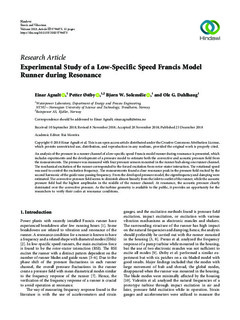| dc.contributor.author | Agnalt, Einar | |
| dc.contributor.author | Østby, Petter Thorvald Krogh | |
| dc.contributor.author | Solemslie, Bjørn Winther | |
| dc.contributor.author | Dahlhaug, Ole Gunnar | |
| dc.date.accessioned | 2019-09-10T05:59:44Z | |
| dc.date.available | 2019-09-10T05:59:44Z | |
| dc.date.created | 2018-12-24T12:24:26Z | |
| dc.date.issued | 2018 | |
| dc.identifier.citation | Shock and Vibration. 2018, 2018 . | nb_NO |
| dc.identifier.issn | 1070-9622 | |
| dc.identifier.uri | http://hdl.handle.net/11250/2614353 | |
| dc.description.abstract | An analysis of the pressure in a runner channel of a low-specific speed Francis model runner during resonance is presented, which includes experiments and the development of a pressure model to estimate both the convective and acoustic pressure field from the measurements. The pressure was measured with four pressure sensors mounted in the runner hub along one runner channel. The mechanical excitation of the runner corresponded to the forced excitation from rotor-stator interaction. The rotational speed was used to control the excitation frequency. The measurements found a clear resonance peak in the pressure field excited by the second harmonic of the guide vane passing frequency. From the developed pressure model, the eigenfrequency and damping were estimated. The convective pressure field seems to diminish almost linearly from the inlet to outlet of the runner, while the acoustic pressure field had the highest amplitudes in the middle of the runner channel. At resonance, the acoustic pressure clearly dominated over the convective pressure. As the turbine geometry is available to the public, it provides an opportunity for the researchers to verify their codes at resonance conditions. | nb_NO |
| dc.language.iso | eng | nb_NO |
| dc.publisher | Hindawi Publishing Corporation | nb_NO |
| dc.rights | Navngivelse 4.0 Internasjonal | * |
| dc.rights.uri | http://creativecommons.org/licenses/by/4.0/deed.no | * |
| dc.title | Experimental Study of a Low-Specific Speed Francis Model Runner during Resonance | nb_NO |
| dc.type | Journal article | nb_NO |
| dc.type | Peer reviewed | nb_NO |
| dc.description.version | publishedVersion | nb_NO |
| dc.source.pagenumber | 12 | nb_NO |
| dc.source.volume | 2018 | nb_NO |
| dc.source.journal | Shock and Vibration | nb_NO |
| dc.identifier.doi | 10.1155/2018/5796875 | |
| dc.identifier.cristin | 1647086 | |
| dc.relation.project | Norges forskningsråd: 257588 | nb_NO |
| dc.relation.project | Norges forskningsråd: 254987 | nb_NO |
| dc.description.localcode | © 2018 Einar Agnalt et al. This is an open access article distributed under the Creative Commons Attribution License, which permits unrestricted use, distribution, and reproduction in any medium, provided the original work is properly cited. | nb_NO |
| cristin.unitcode | 194,64,25,0 | |
| cristin.unitcode | 194,64,92,0 | |
| cristin.unitname | Institutt for energi- og prosessteknikk | |
| cristin.unitname | Institutt for maskinteknikk og produksjon | |
| cristin.ispublished | true | |
| cristin.fulltext | original | |
| cristin.qualitycode | 1 | |

